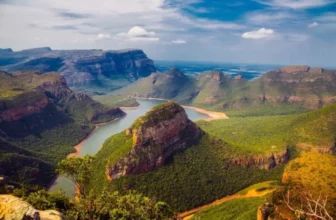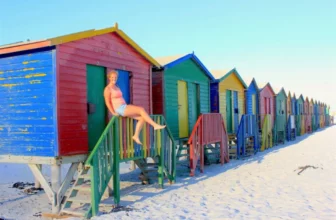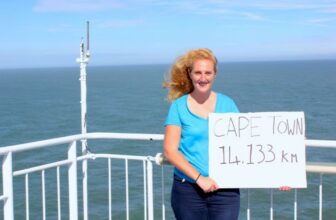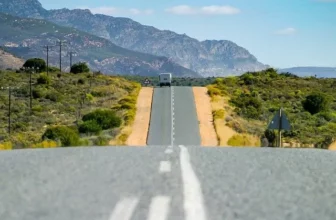Having researched the best time to visit South Africa and booked a flight, you’re left with hundreds of options on what to do. If you’ve never visited the country before and need help planning your trip, this South Africa travel guide will help. If you’re planning to see the country independently, this 7 day South Africa itinerary is a great starting point.
PRO TIP: If you’re planning to travel in South Africa, be it on a budget or on a luxury tour, I can’t emphasise enough how important it is to have decent travel insurance – especially if you plan to tour by bike or scooter. I always use World Nomads, as they’re known as the best insurer for backpackers and long term travellers.
Simply put: South Africa is very large in size and diversity; thus, it has a lot to offer. You won’t be able to see everything within less than four weeks or so, but even with only a week to spare, there’s no reason not to come to South Africa!
Here’s a great itinerary for a week’s self-drive adventure from Johannesburg. We’ve actually done this twice now, because we loved it so much and it’s so affordable!
Seven days / six nights is the perfect amount of time for a road trip North of Johannesburg. You’ll fly into Johannesburg, then visit Pretoria and continue to the Panorama Route. This is a stunning scenic drive, visiting lots of tall waterfalls and the Blyde River Canyon, one of the deepest canyons on earth. The world-famous Kruger National Park lies just a couple of hours from here. Its wildlife is amazingly diverse, you’ll be able to spot everything from antelopes to zebras. We also saw multiple lions, giraffes, cheetahs, rhinos, hippos, even the odd leopard and a whole lot of other animals. There’s the option of either driving around in your own car, or book guided safari tours in National Parks – Both options are great!
Before you ask: Yes, it is absolutely safe do drive in South Africa on your own. The infrastructure is well developed and people are used to visitors and travellers. At the same time though, it certainly doesn’t feel like it’s overcrowded with tourists, which is great. Obviously traffic can get busy in Johannesburg and in the wildlife areas you should obey general rules of safety, but it really isn’t a problem. After all, we remember South Africans as very calm drivers, which made it surprisingly easy to navigate throughout the larger cities.
READ NEXT: Where To Stay In Cape Town
7 Day South Africa Itinerary
Day 1: Landing in Johannesburg, Carlton Centre
Most long-haul flights get into Johannesburg in the late afternoon, and only few in the morning. After a transcontinental journey, we prefer not to have a long drive ahead of us, so we would recommend staying in Johannesburg for the first night.
There really isn’t that much to see in the city and Johannesburg is often regarded to as fairly ‘boring’ compared to the other cities throughout the country. We didn’t think that was far from the truth, and thus one night should be enough.
First of all, pick up your rental car at the airport. Rental cars in South Africa are super cheap. For a Toyota Corolla sized car, expect to pay only about US$30 to 40 a day including all insurances. Smaller cars are even less, but you’ll likely have some luggage with you.
For the rest of the day, you could visit the Carlton Centre, once the tallest building in the southern hemisphere. It was completed in 1973, and many celebrities and government officials have stayed there until the 1990s. Today, the hotel is closed, but the Carlton Centre itself features a viewing platform on its top floor. It’s a great place to come for sunset and stay until it’s dark. Make sure to come by car though, as some surrounding streets are rather uninviting for pedestrians after dark.
If you’re into shopping, be it clothes or electronics, you might want to visit a mall while you’re here. We got a great deal on a brand-new camera for about 30% less than it was in Europe! There is a mid-sized mall on the lower floors of the Carlton Centre as well, or lots around the suburbs.
Where to stay in Johannesburg?
If you want to meet other people, look no further than Curiocity Backpackers. It’s a super cool hostel in the middle of Johannesburg with amazing staff as well as cheap food and drinks. The area might seem a bit weird at first, but they’ve got security guards all around the hostel and the streets, so no worries! We loved our time there. In terms of hotels, the Glenalmond Sandton usually offers some fantastic value in a good location. One of the best hotels in Johannesburg is the Michelangelo at Nelson Mandela Square.
Day 2: Driving to Graskop and start of Panorama Route
On the first full day, head out to the countryside. A good starting point for the Panorama Route will be Graskop, so that’s a perfect stop for tonight. Graskop is about a 4 1/2-hour drive away from Johannesburg, with a cave and lots of waterfalls already leading up to it. If you want to visit all the places on the list, you should plan seven or eight hours for the trip. We highlighted the ones that we enjoyed most, but personal preferences are different! They’re all worth stopping for.
- Sudwala Caves
- Bridal Veil Falls (access by smooth gravel road only)
- Lone Creek Falls
- Horseshoe Falls (access by rough gravel road only)
- Sabie Falls
- Mac Mac Pools
- Mac Mac Falls
All of these are actually on the very last part of the journey: From where you turn off the highway to Mozambique to just before Graskop. Google Maps is a great help when figuring out the way to go. All of the sights mentioned above are easily accessible by car and a very short walk.


What’s more: All the falls and viewpoints cost between 5 Rand per car and 20 Rand per person (as of 2024). That means all these amazing locations will only set you back between US$0.10 and US$1.50 a person… can’t complain about that, right!?
You’ll soon notice that South Africa mostly has better roads, than many other (wealthier) countries around the world. Nice to drive on, very wide and not busy, few potholes, and so on. That makes for a very pleasant drive, especially with all that scenery around you!
Where to stay? If you’re after some good value accommodation, try Mogodi Lodge or Sheris Lodge. These start at around US$40 for a little bungalow or US$15 for a dorm bed. If you’re willing to spend a bit more (still starting at only US$60), then Thaba Tsweni Lodge is a great place, but keep in mind it’s located a few miles down the road in Blyde, not in Graskop. Alternatively, the Westlodge in Graskop (US$120) is probably the most upscale option.
READ: Budget Guide To South Africa: How Much Will Your Trip Cost?
Day 3: Panorama Route and driving to Kruger Park
Hope for good weather on this day! The actual Panorama Route will take you along the rim of the Drakensberg Mountains. It includes some of the most famous viewpoints in South Africa, like the Three Rondavels or God’s Window. By the end of the day, you’ll want to be inside Kruger Park, so make sure to not get up too late. Rest Camps in the park have to be reached before sunset and all the viewpoints and waterfalls along the Panorama Route do take up a considerable amount of time. Roughly in the following order you can visit these points of natural beauty:
- The Pinnacle Rock Viewpoint
- God’s Window & Rainforest Trail
- Wonder View Viewpoint
- Lisbon Falls
- Berlin Falls
- Bourke’s Luck Potholes
- Lowveld Viewpoint
- Three Rondavels Viewpoint
- Upper & Lower Blyde River Canyon Viewpoint
- Echo Caves



All you need to do is make sure to leave the last viewpoint (or cave) at least three hours before the gate closing time of Satara Rest Camp.
Camps in the park: There are a lot of different options, and we only stayed in the main camps. Next time, we’d like to check out some of the more adventurous options though. Check out all the different forms of camps on the parks website here. That’s also where you can (and should) book the camps, preferably multiple months before setting off on your trip.
Where to stay? Satara Rest Camp is a great stop for the first night. Easily accessible from the outside world through Orpen Gate, and far enough inside the park to get the “middle of nowhere” feeling. Soon after we arrived, we saw a herd of Wildebeest grazing in the sunset, some 50 metres from our car while we were having a barbecue.
Day 4: Kruger Park (Satara to Lower Sabie)
No South Africa Itinerary would be complete without a wild safari adventure! Satara to Lower Sabie makes for a good day drive. While in Kruger National Park, please obey the rules and never go faster than 50 km/h on sealed and 30 or 40 km/h on unsealed roads. It may seem slow at times, but you’re essentially driving right through their habitat and something could jump out of the bushes at any given time. After all, the animals are what you’re coming here for, so please respect them 🙂
If you want to get off the main roads on the way down to Lower Sabie, go via N’wanetsi Road and Trichardt Road. Nobody around, lots of undisturbed wildlife, and some great lookouts (Sweni Hide and especially N’wanetsi Lookout) are waiting for you. You’ll likely come across some hippos and crocodiles here. On Trichardt Road, we also spotted the only cheetahs we’ve ever seen in the park!
If needed, stop for lunch back on the main road at Tshokwane Picnic Site and then head further south. Nkumbe Lookout is a good stop along the way with some endless view over the vast plains.
Lower Sabie was our favourite camp. It is quite modern and situated right by Sabie River, only a few miles from Mozambique. You can even hear the hippos in the water at night, and the breakfast restaurant offers great views too.
Where to stay? Lower Sabie Rest Camp. It is very popular though, so make sure to book it months in advance if you’re going in high season!
Day 5: Kruger Park (Lower Sabie to Pretoriuskop / Berg en Dal)
Another full day to enjoy the South African wildlife! Driving along the banks of Sabie River and Sand River, we were lucky and spotted multiple lions. A great piece of advice: Speak to other people you come by, especially if they’re going the other way. They might have seen something interesting and will gladly point you towards it. This way, we managed to see five lions within half an hour!
There are a lot of roads in this park of the park, as it is the busiest part. Nevertheless, most of the time you’ll see no car but your own one. The many roads make for some good options to explore, even though the driving distance to Pretoriuskop isn’t that far. By the way: If you see signposted viewpoints anywhere, go explore them. All around the park we found some hidden gems that weren’t on our maps, but offered great views with not many people around.
If you’ve got time left over, you might want to book a proper game drive in one of the camps. Most of them offer morning and evening or even night drives, and they usually cost around US$20 to 40 per person. You’ll go in a car like this:
Where to stay? Either Pretoriuskop Rest Camp or Berg en Dal Rest Camp. It depends how much driving you think you’ll want to do. They are both good and modern camps, we did like Pretoriuskop a bit more though. That will also give you the option of enjoying one last drive through Kruger Park the next morning.



Day 6: Kruger Park to Pretoria
If you’ve already made your way down to Berg en Dal, you can just exit from there through Malelane Gate and you’re on the way for a straight four-hour drive to Pretoria.
If you stayed the night at Pretoriuskop, just see how you feel. A bit more safari? Take the two-hour drive down to Malelane Gate and Crocodile River and drive to Pretoria from there.
Got enough of animal spotting? Exit straight though Numbi Gate and it’ll be four hours to Pretoria right from there.
Pretoria is one of the three South African capital cities, the other two being Cape Town and Bloemfontein. It’s famous for the large amount of beautiful purple Jacaranda trees. These usually bloom from mid or late September until mid or late November. Some great things to do in or near Pretoria are:
- Harties Cableway, a scenic cableway near Hartbeespoort Dam offering some of the greatest views in the area.
- Wonderboom Nature Reserve, a hillside reserve just north of Pretoria containing impressive fig trees.
- The Union Buildings, the official government seat. The Nelson Mandela Statue is located here as well.
Where to stay? Good value and central options in Pretoria include the Treetops & Treats, the Farmers Folly and The Park Lodge, which you can all book for around US$50 or 60. If you feel like spending some more cash, the Ntshavheni Lodge, the Villa Sterne, or the Illyria House might suit your desire. In terms of chain hotels, the Holiday Inn Express and the Sheraton offer decent value.
Day 7: See Pretoria, drive back to Johannesburg
Since almost all intercontinental flights leave Johannesburg in the evening, you can spend part of the day visiting more places around Pretoria and then drive back to Johannesburg Airport, drop off the car and wait for your departure. Factor in some rush hour delays and the car return, so leave Pretoria no later than four hours before your flight.
Important facts about weather and high / low season
This is an important topic to consider and to have a think about. South Africa gets hot summers and mild to cold winters. Keep in mind it’s in the Southern Hemisphere so January is the hottest and July the coldest month. Summer is the rainy season with lots of afternoon thunderstorms, while winter offers crystal clear skies for weeks on end.
Kruger Park has a subtropical and Johannesburg a subtropical highland climate. While Kruger Park is between 200 and 850 metres in elevation, Johannesburg lies 1,750 metres above ground. Temperatures in summer can exceed 100°F (38ºC) in both places, along with nice and warm nights. Winter days will still reach up to around 75 to 80ºF (roughly 25ºC), but as soon as the sun goes down, temperatures drop. While it’s common to wake up to about 40 or 45ºF (roughly 4 to 7ºC), they do drop below freezing on a regular basis, especially in Johannesburg. The Panorama Route area is generally more humid and foggy or rainy.
Many people say the best time to go to Kruger for watching the animals is winter. Vegetation is sparse, allowing you to see a lot more, and animals will be a lot more present at water holes, because it doesn’t rain. Personally, we would find it to be too cold though. We’ve been twice (late October and mid-December), and going in October seemed to be perfect! It was very warm but not yet humid and it didn’t get cold at night. Vegetation was still kind of sparse, it didn’t rain, and there were not many people in the park. Literally the perfect combination, and the Jacaranda trees in Pretoria and Johannesburg will be in full bloom too! March and April offer similar weather.
Tip: Try to avoid South African school holidays, if possible.
Last but not least: Obviously there is always the more luxurious option of staying at a safari lodge instead of the rest camps. It is a lot more expensive, but also a completely different experience.

We tried it out and stayed at Klaserie Sands River Camp for a few nights, which was absolutely mind-blowing! The accommodation price includes everything, from full board to spirits to game drives and more. The whole team was fantastic and so nice to us, and the game drives for sunrise and sunset in their converted Landcruiser were equally great with our extremely knowledgeable guides. This was the lodge:
Author Biography:
Emma Lomas & Yannick Westphal are the British and German couple behind the travel blog, Luxurybackpacking. Having travelled to over 43 countries before they reached 21, they are now full-time bloggers and social media influencers. Follow their journey as they teach others how to travel in luxury for less! Check them out on Facebook, Twitter and Instagram.





